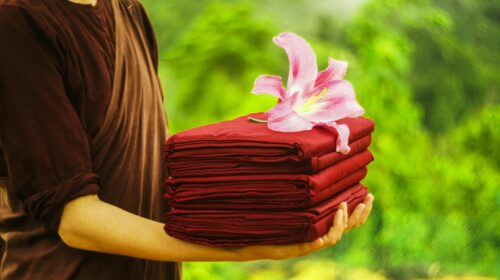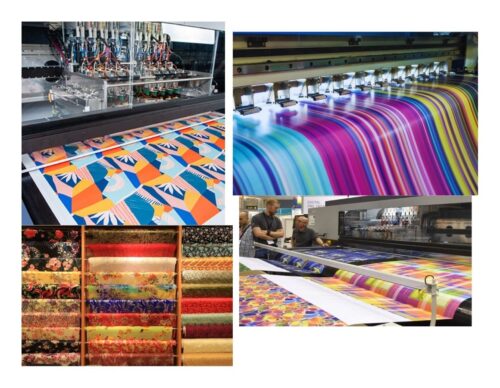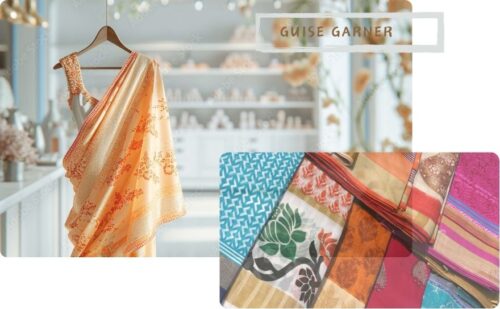“It is known as the “Indian Sun” in the world of fashion. Yes, Banarasi Silk Saree-A luxury is undoubtedly the desired fabric all around the world.” It is know for it’s Thick and Beautiful Needlework.
Banarasi silk saree the first choice of a bride attire. it’s a type of Traditional Indian garment, originating from the Beautiful And Cultural Rich city of Varanasi (also known as Banaras) in Uttar Pradesh, India. Banarasi Silk Saree – A Luxury is known for its intricate designs, gold and silver brocade, and fine silk fabric.
It is always considered to be one of the finest and most luxurious sarees in India and are often worn for special occasions and ceremonies.
Let’s explore this beauty by below topics:
- History And Origin
- Different names of Banarasi Silk Saree in different Regions
- Making of Banarasi Silk Saree
- Weaving techniques of Banarasi Silk Saree
- Why is Banarasi Silk Saree
- How to Identify Pure Banarasi Silk Saree
- How to Style Banarasi Silk Saree
- Price Range
- Best buying Option
History And Origin
Banaras was a thriving center of the cotton textile industry, as noted by Ralph Fitch (1583-91). While the earliest mentions of Banaras’ brocade and Zari textiles date back to the 19th century, it is likely that silk brocade weaving began in Banaras in the 17th century when silk weavers migrated from Gujarat during the Famine of 1603. The craft flourished in the 18th and 19th centuries.
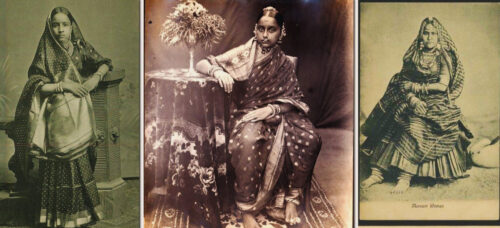
Know more About Saree History via History of Saree Draping.
During the Mughal period, which started around the 14th century, weaving intricate brocades using gold and silver threads became Banaras’ specialty. The rich history is the cause of Banarasi Silk Saree – A Luxury.
Today, around 1.2 million people are directly or indirectly associated with the hand-loom silk industry in the region encompassing Gorakhpur, Chandauli, Bhadohi, Jaunpur, and Azamgarh districts.
In recent years, several independent, Varanasi-based brands have emerged to revive the Banarasi sari and make them more accessible to mainstream consumers, including Ekaya, Tilfi Banaras, and HKV Banaras, among others.
Different names of Banarasi Silk Saree in different Regions
Banarasi silk is a luxurious and sought-after fabric in India, especially for sarees. In Hindi, it is called Banarasi Reshami Sadi, while in Bengali, it is known as Benarasi Reshami Sari. Gujarati refers to it as Banarasi Resham Sadi, while Telugu calls it Banarasu Pattu chira, and Tamil as Vanarasi Paavaada. Kannada uses the term Banarasi Pattu Saree, while Marathi refers to it as Shalu. Punjabi, call it Banarasi Reshami Sari and , Banarasi Reshami Shaal in Kashmir.

In addition to the above-mentioned names, Banarasi silk sarees are also known as Banarasi Katan Sarees, Banarasi Brocade Sarees, and Banarasi Jamdani Sarees in different regions of India. In some parts of the country, people refer as “Kinkhwab” or “Kinkab” sarees, which symbolise to the rich and opulent nature of the fabric. In the western states of India, such as Maharashtra and Gujarat, they are often called “Sona Rupa” sarees, which means “golden and silver” due to the intricate zari work used in their making.
It is known by various names In different parts of the world. For example, in the Middle East, they are referred to as “Benares silk” or “Banaras silk” sarees. In Southeast Asia, they are known as “Benarasi silk” or “Benares silk” sarees. In the United States, they are often called “Banarasi brocade” sarees, while in Europe, they are known as “Benarasi brocade” sarees.
Making of Banarasi Silk Saree – A Luxury
The process of weaving a Banarasi Silk Saree is a complex and intricate one that requires a great deal of skill, patience, and attention to detail. The duration of making this beauty is around 2 month for a Saree. Here is a step-by-step guide to the weaving process:
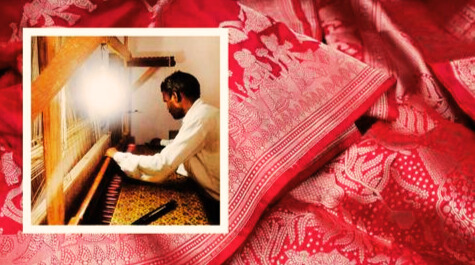
Designing the Saree
- After finalizing the design to be woven, it is converted into a graph paper measured in inches. This process is known as “likhai” and is carried out by a local grapher called a “Nakshaband.” The Naksha, which is meticulously designed and accurate, serves as a blueprint that is manually punched onto cardboard stencils known as “Naksha Pattas.” The complexity of the weaving increases with the number of grids per inch on the fabric, resulting in a higher level of intricacy and weaving difficulty.
- The Naksha Pattas are connected together in a chain-like structure and then affixed to the Jacquard loom. Collectively, the cards form the necessary mechanism to raise the appropriate yarns during the weaving process to create a specific design and transfer the pattern onto the fabric. The number of graphing cards required for weaving can range from a few hundred to several thousand, depending on the complexity of the design of the Banarasi saree. A larger size and greater number of Naksha Pattas correspond to a more intricate pattern.
Preparing the Silk Yarn
The first step in weaving a Banarasi Silk Saree is to prepare the silk yarn. The silk yarn is washed and boiled in a mixture of water and soda ash to remove any impurities and to make it stronger and more durable. It is then sun-dried and wound onto bobbins.
Setting up the Loom
The next step is to set up the loom. The warp threads are tied onto the loom and the design is transferred onto the warp threads using a technique called ‘Tana Bana’. The weaver then sets up the shuttles with the weft yarn and begins weaving the saree.
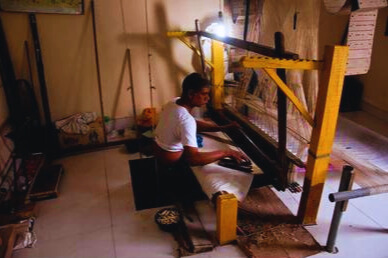
Weaving the Saree
The weaver begins weaving the saree from the bottom edge, working upwards towards the pallu. The weft yarn is passed through the warp threads, and the weaver uses a technique called ‘kadhuwa’ to create the intricate designs and patterns. This involves inserting additional weft threads into the warp threads to create a raised design.
Adding Zari and Border
Once the saree is woven, the weaver adds the zari and border. The zari is a metallic thread that is woven into the saree to create a beautiful and intricate design. The border is also woven into the saree and can be made of silk or zari.
Finishing the Saree
Finally, the saree is finished by cutting it from the loom and removing any excess threads. It is then washed and ironed, and the pallu is attached. The saree is now ready to be sold and worn, a masterpiece of artistry and craftsmanship.
Weaving techniques of Banarasi Silk Saree – A Luxury
The process involves a combination of traditional techniques and innovative methods. Skilled karigars use their expertise to create intricate designs that are both beautiful and unique.
Here are some of the techniques and keywords used in the design making process:
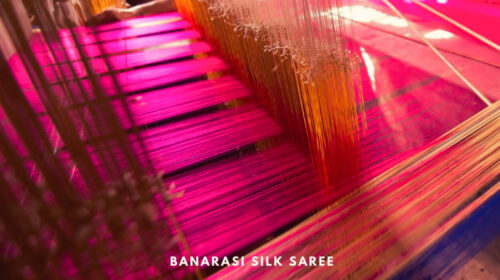
- Jacquard Weaving: Jacquard weaving is a technique used to create intricate patterns using a loom with a punched card system. This method allows for greater precision and detail in the design.
- Kadhuwa: Kadhuwa is a technique of hand weaving that involves using small wooden sticks to create intricate designs. This technique requires a high level of skill and patience.
- Meenakari: Meenakari is a traditional technique of adding colorful enamel work to metal. In the context of Banarasi Silk Saree design, meenakari is used to add colorful accents to zari work.
- Zari Work: Zari work is a type of embroidery that involves using metallic threads to create intricate designs. The threads are made of fine silver or gold wire that is wrapped around a silk or cotton core. Zari work adds a beautiful metallic sheen to the design.
- Butidaar: Butidaar is a technique of adding small flower motifs to the saree design. These motifs are created using a small needle and thread and are often used in combination with zari work.
- Tanchoi: Tanchoi is a technique of creating intricate designs using a combination of silk and zari threads. The silk threads are used to create the base design, while the zari threads are used to add accents and highlights.
- Jangla: Jangla is a technique of adding small, repeating patterns to the saree design. These patterns are often floral or paisley motifs and are created using zari or silk threads.
- Kalka: Kalka is a technique of creating large, intricate designs along the border of the saree. These designs often feature repeating patterns and are created using a combination of zari and silk threads.
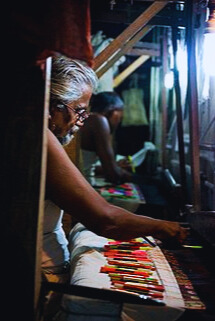
The design making process of a Banarasi Silk Saree involves a combination of traditional techniques and innovative methods.
Skilled karigars use their expertise to create intricate designs using techniques such as jacquard weaving, kadhuwa, meenakari, zari work, butidaar, tanchoi, jangla, and kalka.
The end result is a truly beautiful and unique piece of clothing that is not just a saree, but a piece of cultural heritage and traditional craftsmanship that deserves to be celebrated and cherished.
Why is Banarasi Silk Saree – A Luxury
Banarasi sarees are considered a luxury for several reasons:
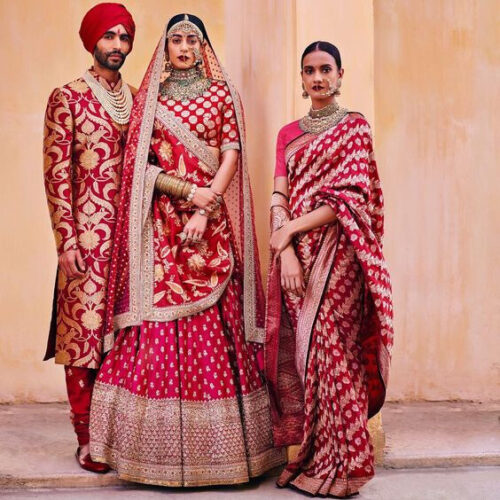
Handcrafted: Banarasi Silk Saree – A Luxury are handcrafted by skilled weavers in Varanasi using traditional techniques that have been passed down for generations. Each saree can take anywhere from a few days to several months to complete, depending on the complexity of the design.
Rich Fabrics: Banarasi sarees are typically made from rich fabrics such as silk, cotton, and gold or silver zari. These fabrics are expensive and require skilled craftsmanship to weave.
Intricate Designs: Banarasi sarees are known for their intricate designs, which often feature floral or paisley motifs, as well as intricate borders and pallus. These designs are created using a technique called jacquard weaving, which requires a high level of skill and precision.
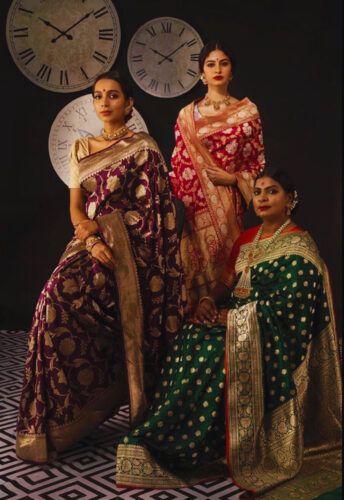
Historical significance: Banarasi sarees have a rich cultural and historical significance. They were first woven in Varanasi over 500 years ago and were traditionally worn by royalty and aristocrats. Today, they are still considered a symbol of luxury and are often worn at weddings and other special occasions.
Limited availability: Since Banarasi sarees are handcrafted, each one is unique and takes a considerable amount of time and effort to create. As a result, they are often produced in limited quantities, which adds to their exclusivity and value.
How to Style Banarasi Silk Saree
Here are some of the most popular styles of draping a saree:

Nivi Style: This is the most popular and traditional style of draping a saree, where the saree is draped over the left shoulder and the pallu is brought back over the right shoulder.
Bengali Style: This style involves draping the pallu over the left shoulder and then taking it back under the right arm and over the left shoulder again. The pleats are tucked in at the back.
Gujarati Style: In this style, the pallu is draped from the back to the front, and then brought back over the right shoulder. The pleats are tucked in the front, and the remaining fabric is draped over the left shoulder.
Maharashtrian/Nauvari Style: This style is unique to the Maharashtrian saree draping tradition. This involves creating a trouser-like drape with the saree, instead of the usual skirt-like drape. In Maharashtra there many attractive ways to drape banarasi silk saree and each draping has a different name.
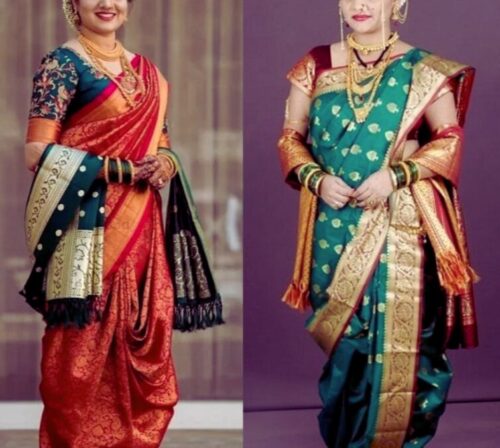
Tamilian Style: In this style, the saree is draped in a way that the pallu is worn over the right shoulder, and the pleats are tucked in at the waist on the left side.
Kerala Style: This style is similar to the Tamilian style, but the saree is draped in a way that the pallu is worn over the left shoulder.
Mermaid Style: In this style, the saree is draped tightly around the legs and then the pallu is draped like a dupatta over the head and one shoulder.
Butterfly Style: This style involves draping the saree in such a way that it looks like butterfly wings. The saree is tucked in at the back and brought over the left shoulder, with the pleats arranged to look like butterfly wings.
Mumtaz Style: This style was made famous by actress Mumtaz in the 1970s. The saree is draped in such a way that the pleats are arranged in a way that they cover the legs, and the pallu is draped over the head and one shoulder.
Know more about Saree draping style go on link https://guisegarner.com/category/fashion/
Few of fusion ways to drape in style:
Rajrani Style: The Rajrani style of draping a saree is a regal and elegant style. It involves making pleats at the front and draping the remaining fabric over the right shoulder. Then the pallu is draped over the left shoulder and brought back to the front, creating a V-shape at the front.

Pant Style: The Pant style of draping a saree is a modern and trendy style. It involves wearing a pair of pants and tucking the saree into the waistband of the pants, creating a dhoti-like look. The pallu is then draped over the left shoulder.
Half Saree Style: The Half Saree style involves draping the saree in a way that it looks like a half saree. The saree is tucked into the waistband on the left side, and the pallu is draped over the left shoulder, brought back to the front, and tucked into the waistband on the right side.
Lehenga Style: The Lehenga style of draping a saree involves tucking the saree into the waistband of a long skirt instead of a petticoat. The saree is then draped over the skirt, creating the look of a lehenga.

Each of these styles offers a unique look and can be chosen based on personal preferences and the occasion. Know more about Saree draping style go on link https://guisegarner.com/category/fashion/
How to Identify Pure Banarasi Silk Saree
Identifying a pure Banarasi silk saree can be a daunting task. But there are a few things that can be look out:

- Look for the Silk Mark Label: important thing to check for while buying pure silk Saris is the Certificate of Authorised use of the Silk Mart logo. Always, insist on the certificate if you are buying a pure silk sari.
- Check the Weave: When you go to buy a Banarasi saree just pull its other side up i.e. reverse the saree to check for floats between the grids of warps and wefts on the saree. Only a hand-woven Banarasi saree will boats of such warp and weft technique. The machine fails to replicate that. Another way to identify a real Banarasi saree is to check for pin marks. These fix a handloom saree to the loom and usually found on the selvage of the saree.”
- Examine the Design: Traditional Banarasi silk sarees have intricate floral or paisley designs. While modern designs may have more contemporary motifs. You will notice that it mostly carries the Mughals patterns like amru, ambi and domak and there should be no loose threads or hanging zari.
- Check the Weight: Pure Banarasi silk sarees are heavy because of the use of real silver or gold threads in the weaving process. If the saree feels lightweight, it may not be authentic.
- Burn Test: Take a few loose threads from the saree and burn them. If they burn completely leaving no residue, it is pure silk. If there is a smell of burning plastic or rubber, it is not pure silk.
- Price: Pure Banarasi silk sarees are expensive due to the quality of silk and the intricate weaving process. If the price seems too good to be true, it probably is, and the saree may not be authentic.
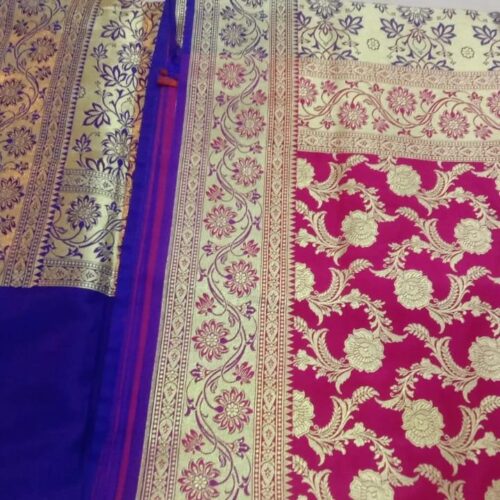
Recently, Banarasi sarees have got their own GI [geographical indication] protection against all the Chinese and Surat made saris. This an IPR i.e. (Intellectual Property Right) to help people identify the original Banarasi sarees made from the six districts of Uttar Pradesh state in India [Varanasi, Azamgarh, Chandauli, Jaunpur, Mirzapur and Sant Ravi Dass Nagar – Bhadohi].
Price Range
The price range of Banarasi silk sarees can vary widely depending on several factors. Such as the quality of silk, the intricacy of the design, the amount of zari work, and the brand. Here is a general guide to the price range of Banarasi silk sarees:
- Budget range: Banarasi silk sarees in this range typically start from around Rs. 3,000 to Rs. 5,000. These sarees may have less intricate designs and less zari work.
- Mid-range: Banarasi silk sarees in this range typically range from Rs. 5,000 to Rs. 15,000. These sarees may have more intricate designs and more zari work.
- High-end range: Banarasi silk sarees in this range can cost upwards of Rs. 15,000 and can go up to several lakhs. These sarees are typically made from the finest quality silk, have intricate designs with a lot of zari work, and may be created by well-known designers or brands.
- It’s important to note that the above price ranges are indicative. This can be vary depending on various factors such as the location, the brand, and the quality of the silk.
Best buying Option
If you’re looking to buy a Banarasi silk saree, there are several options available:
- Visit Varanasi: Varanasi is the home of Banarasi sarees, so if you have the opportunity, visiting the city and purchasing a saree from a local weaver or shop is an excellent option. This way, you can see the sarees in person, check the quality, and even customize the design to your liking.
- Online shopping: Many online retailers offer a wide range of Banarasi silk sarees, including popular e-commerce sites such as Amazon, Flipkart, and Myntra. However, it’s important to research the seller’s reputation and reviews before making a purchase to ensure that you’re getting an authentic saree.
- Boutique stores: Many specialty stores and boutiques specialize in traditional Indian clothing, including Banarasi silk sarees. These stores may offer a more personalized shopping experience, and you can try on different sarees to find the one that suits you best.
- Direct from weavers: Some weavers and cooperatives sell their Banarasi silk sarees directly to customers, either online or in-person. This can be an excellent option if you’re looking to support local artisans and get a unique, high-quality saree.
When buying a Banarasi Silk Saree – A Luxury, it’s essential to pay attention to the quality of the silk, the intricacy of the design, and the reputation of the seller. With a little research and careful consideration, you can find the perfect perfect Banarasi silk saree to add to your collection.
Your readership is a gift we cherish! Thank you! Please share if You found it useful.


